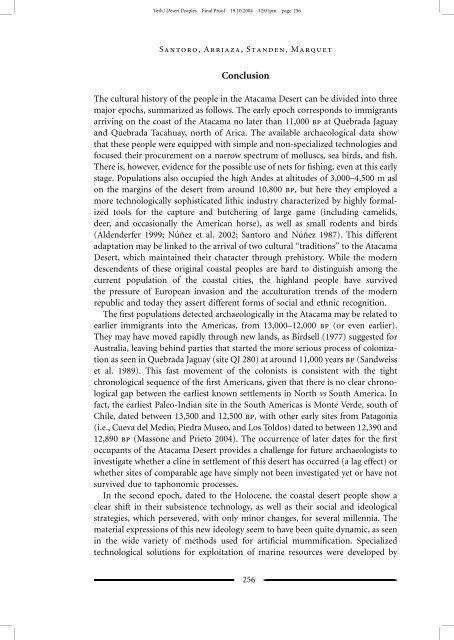You also want an ePaper? Increase the reach of your titles
YUMPU automatically turns print PDFs into web optimized ePapers that Google loves.
Veth / <strong>Desert</strong> <strong>People</strong>s Final Pro<strong>of</strong> 19.10.2004 12:01pm page 256Santoro,Arriaza,Standen,MarquetConclusionThe cultural history <strong>of</strong> <strong>the</strong> people in <strong>the</strong> <strong>Atacama</strong> <strong>Desert</strong> can be divided into threemajor epochs, summarized as follows. The early epoch corresponds to immigrantsarriving on <strong>the</strong> coast <strong>of</strong> <strong>the</strong> <strong>Atacama</strong> no later than 11,000 bp at Quebrada Jaguayand Quebrada Tacahuay, north <strong>of</strong> Arica. The available archaeological data showthat <strong>the</strong>se people were equipped with simple and non-specialized technologies andfocused <strong>the</strong>ir procurement on a narrow spectrum <strong>of</strong> molluscs, sea birds, and fish.There is, however, evidence for <strong>the</strong> possible use <strong>of</strong> nets for fishing, even at this earlystage. Populations also occupied <strong>the</strong> high Andes at altitudes <strong>of</strong> 3,000–4,500 m aslon <strong>the</strong> margins <strong>of</strong> <strong>the</strong> desert from around 10,800 bp, but here <strong>the</strong>y employed amore technologically sophisticated lithic industry characterized by highly formalizedtools for <strong>the</strong> capture and butchering <strong>of</strong> large game (including camelids,deer, and occasionally <strong>the</strong> American horse), as well as small rodents and birds(Aldenderfer 1999; Núñez et al. 2002; Santoro and Núñez 1987). This differentadaptation may be linked to <strong>the</strong> arrival <strong>of</strong> two cultural ‘‘traditions’’ to <strong>the</strong> <strong>Atacama</strong><strong>Desert</strong>, which maintained <strong>the</strong>ir character through prehistory. While <strong>the</strong> moderndescendents <strong>of</strong> <strong>the</strong>se original coastal peoples are hard to distinguish among <strong>the</strong>current population <strong>of</strong> <strong>the</strong> coastal cities, <strong>the</strong> highland people have survived<strong>the</strong> pressure <strong>of</strong> European invasion and <strong>the</strong> acculturation trends <strong>of</strong> <strong>the</strong> modernrepublic and today <strong>the</strong>y assert different forms <strong>of</strong> social and ethnic recognition.The first populations detected archaeologically in <strong>the</strong> <strong>Atacama</strong> may be related toearlier immigrants into <strong>the</strong> Americas, from 13,000–12,000 bp (or even earlier).They may have moved rapidly through new lands, as Birdsell (1977) suggested forAustralia, leaving behind parties that started <strong>the</strong> more serious process <strong>of</strong> colonizationas seen in Quebrada Jaguay (site QJ 280) at around 11,000 years bp (Sandweisset al. 1989). This fast movement <strong>of</strong> <strong>the</strong> colonists is consistent with <strong>the</strong> tightchronological sequence <strong>of</strong> <strong>the</strong> first Americans, given that <strong>the</strong>re is no clear chronologicalgap between <strong>the</strong> earliest known settlements in North vs South America. Infact, <strong>the</strong> earliest Paleo-Indian site in <strong>the</strong> South Americas is Monte Verde, south <strong>of</strong>Chile, dated between 13,500 and 12,500 bp, with o<strong>the</strong>r early sites from Patagonia(i.e., Cueva del Medio, Piedra Museo, and Los Toldos) dated to between 12,390 and12,890 bp (Massone and Prieto 2004). The occurrence <strong>of</strong> later dates for <strong>the</strong> firstoccupants <strong>of</strong> <strong>the</strong> <strong>Atacama</strong> <strong>Desert</strong> provides a challenge for future archaeologists toinvestigate whe<strong>the</strong>r a cline in settlement <strong>of</strong> this desert has occurred (a lag effect) orwhe<strong>the</strong>r sites <strong>of</strong> comparable age have simply not been investigated yet or have notsurvived due to taphonomic processes.In <strong>the</strong> second epoch, dated to <strong>the</strong> Holocene, <strong>the</strong> coastal desert people show aclear shift in <strong>the</strong>ir subsistence technology, as well as <strong>the</strong>ir social and ideologicalstrategies, which persevered, with only minor changes, for several millennia. Thematerial expressions <strong>of</strong> this new ideology seem to have been quite dynamic, as seenin <strong>the</strong> wide variety <strong>of</strong> methods used for artificial mummification. Specializedtechnological solutions for exploitation <strong>of</strong> marine resources were developed by_ 256_
















